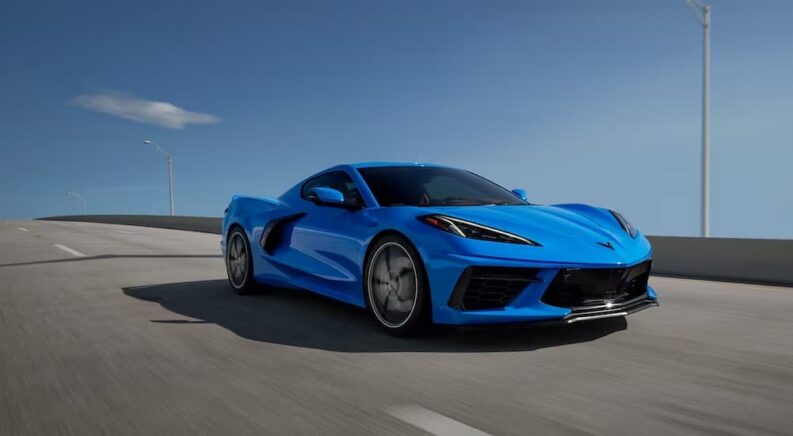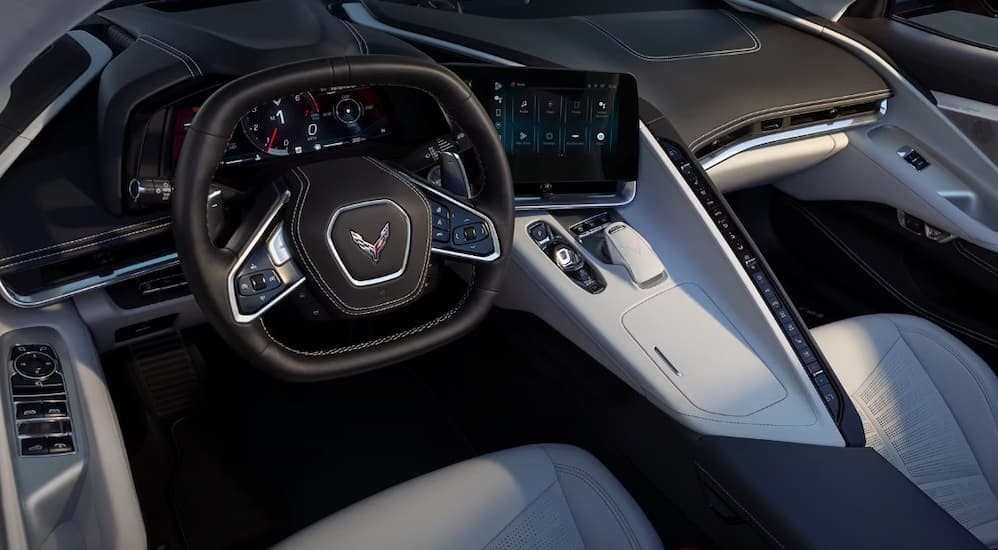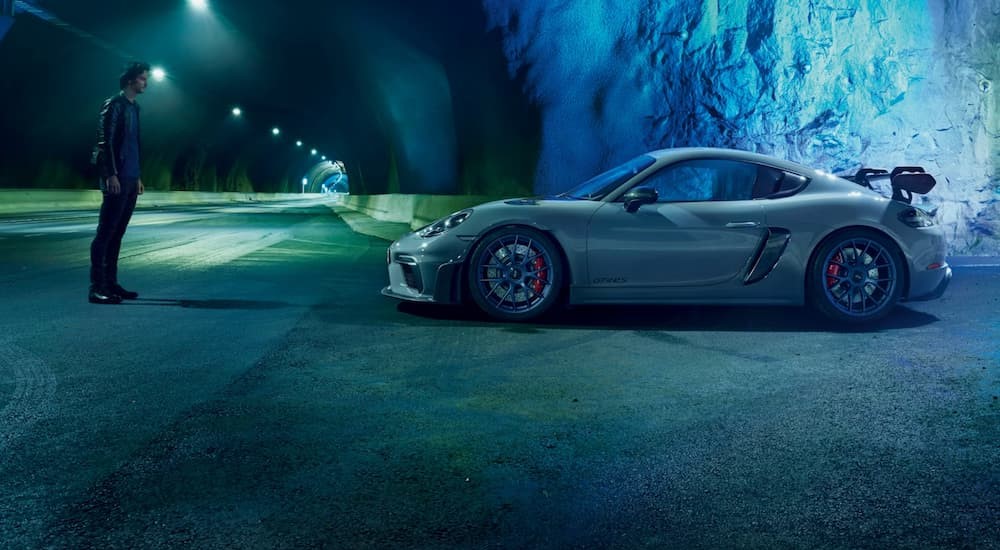The Corvette has been an American automotive icon since it first hit the market in 1953. This sports car’s performance and styling have won it a loyal following, with over 250 grassroots owners clubs across the country. While the Corvette Stingray can rival almost any other model in terms of raw power, this Chevy speedster is occasionally—and perhaps unfairly—maligned as a lesser alternative in the performance-minded segment.
Take the Porsche 718, for example. Both the Corvette and 718 are built around a mid-engine design that makes them a relative rarity in the modern market. Both are available in an open-air body style, with the Porsche using two monikers to differentiate between the Cayman coupe and Boxster convertible. Both the Corvette and 718 offer cutting-edge style, a full suite of advanced tech, and luxurious interior design—so, what separates them? The 718 provides stiff competition for the Corvette, but is it truly the Chevy’s equal, or are drivers ultimately just paying a premium for the Porsche name? Start your engines, because I’m going to get to the bottom of this debate as I pit the Chevy Corvette against the Porsche 718 to see if sourcing a mid-engine maestro is as easy as searching the internet for “Chevy dealer near me.”
Engine
While the Corvette Stingray and 718 might share a few similarities in terms of design, Chevy and Porsche have taken very different approaches when it comes to the goods under the hood (or, in this case, behind the driver’s seat). While the Corvette is offered with a single 6.2-liter V8, the 718 can be had with one of three available engines. Advantage Porsche, right? Not so fast.
While the 718 might offer a lot in the way of customization, the car’s base engine could be a little underwhelming when compared to the Corvette. The 718’s Base trim packs a turbocharged 2.0-liter flat-four, which, while a lot of fun, falls toward the lower end of the power spectrum with 300 hp on tap. A little extra displacement allows the 718 S to produce 350 hp thanks to its 2.5-liter engine, but that still falls well short of the Corvette’s 490 ponies.
There’s also the issue of noise. The 718’s flat-four might be speedy enough for the average driver, but it doesn’t exactly purr like a contented kitten. Porsche has largely solved this problem when it comes to the 718’s 4.0-liter flat-six, which swaps out the turbocharger for a naturally aspirated design. This six-cylinder setup allows the 718 to make 394 hp in the GTS and 493 hp in the GT4 RS/Spyder RS, but those opting for the 718 Base or S might find the smaller engine’s sound to be a little incongruous with the car’s sporty appearance.
The Corvette’s 6.2-liter V8 doesn’t suffer from the same auditory issues, producing a satisfying din that’s made all the better with the addition of the Z51 Package’s dual-mode performance exhaust. Most importantly, this V8 has the bite to back up its bark with 490 hp and 465 lb-ft of torque on tap. The aforementioned dual-mode performance exhaust sweetens the pot even further, adding an extra 25 hp and allowing the Corvette to best the 718’s brawniest engine by a considerable margin.
Advantage: Corvette
Transmission
Debuting in 2020, the eighth-generation Corvette brought a number of changes to the storied badge. While the sports car made some important improvements in terms of style and technology, Chevy’s decision to ditch the manual transmission turned some heads. Automatic transmissions have never been the go-to choice in the athletic segment, and for good reason: While they might be convenient, they’re not always up to the task when it comes to high-performance driving. Between overheating, power loss, and lackadaisical shifts, traditional automatics weren’t really seen as being up to the task.
Eliminating the manual option might have lost the Corvette a few points in the eyes of some sports car purists, but if you’re going to go with an automatic, Chevy has surely picked the right one. The eighth-gen Corvette Stingray’s eight-speed dual-clutch transmission (DCT) combines the best of both the automatic and manual approaches.
Faster, more efficient, and capable of higher speeds than a manual transmission, a DCT uses a computerized shifting system and two clutches to provide quick, precise gear changes. While a driver might take up to a full second to shift gears in a manual, a DCT can shift in as little as 1/10th of a second while reducing the likelihood of the sort of shift shock that can cause accelerated wear and tear. Best of all, a DCT can be manually operated when the urge strikes, giving drivers manual-like control with automatic convenience.
The Corvette’s DCT is a prime example of everything there is to love about the technology. Drivers can easily change gears using two paddle shifters mounted on the steering wheel, which can make all the difference when you’re trying to beat your rival off the line or set a new PR at your local track. It’s hard to argue with Chevy’s deployment of the DCT, especially when you get a look at the Corvette Stingray’s rubber-burning zero-to-60-mph time—but how does the 718 compare?
Porsche has taken a more traditional approach with its mid-engine sports car, offering customers the option of a six-speed manual or a seven-speed DCT dubbed the PDK (Porsche Doppelkupplungsgetriebe, or simply Porsche double-clutch transmission). Like the Corvette, the 718 features steering-wheel-mounted paddle shifters and offers all the advantages of a DCT. The six-speed manual offers a tempting alternative, but it’s hard to make an argument against the DCT outside of pure tradition.
Advantage: Draw
Acceleration
You can spend your time comparing transmissions, engine size, output, and other stats, but at the end of the day, a sports car is best measured by what happens when you really put the pedal to the metal. The zero-to-60-mph test might not be the most sophisticated metric one could use, but if you’re in the market for sophistication, you’d be better off spending your $70,000 to $165,000 on a painting or a rare bottle of wine. Straight-line acceleration separates the high-performance contenders from the underpowered pretenders, so how do the Corvette and 718 stack up?
We’ll start with the 718, which kicks off with a 4.4-second zero-to-60-mph time when opting for the 300-hp flat-four and six-speed manual transmission. That’s not bad, but it’s ultimately sort of pedestrian in a segment where a sub-five-second time is merely average. Upgrading to the GTS with its 4.0-liter engine sees that number reduced to 3.9 seconds, but that’s no match for the range-topping GT4 RS, whose 494-hp engine and seven-speed PDK dual-clutch automatic transmission easily make it the speediest of the bunch with a 2.8-second zero-to-60 time.
This is a strong showing for the Porsche, but there’s one problem: the Corvette has no problem keeping pace. When paired with the Z51 Performance Package and optional FE4 magnetorheological dampers, the Corvette Stingray can match the 718’s lighting-fast acceleration while ringing in at a fraction of the price of the GT4 RS. The 718’s fanciest trim even rivals the cost of Chevy’s bonafide supercar (the $180,000 Corvette Z71), which isn’t a very flattering comparison when you consider the Z71’s 233-mph top speed and rumored 2.3-second zero-to-60-mph time.
Advantage: Corvette
Chevy’s Superior Powertrain
The results are in, and the Corvette Stingray emerges as the clear winner. This decision might not seem so cut and dry, but it ultimately comes down to a matter of value. Even in its priciest 3LT convertible form, the Corvette is still cheaper than nearly half the 718 lineup. The comparison is even more stark when you consider the Porsche’s GT4 RS trim, which, at $160,000, could buy you almost any two Corvettes. This gulf in price wouldn’t be such a big deal if the Porsche could blow its domestic rival out of the water, but that’s simply not the case.
Sure, a Porsche is always going to carry a certain cultural cache, but it’s ultimately a question of how much you’re willing to spend to option a 718 that can keep pace with the Corvette. The eighth-gen Corvette is about as thrilling as they come, and it’s a relative bargain when compared to many of its European competitors. Plus, with the money you save, you can invest in some German lessons that’ll allow you to finally determine if it’s pronounced “Porsch” or “Por-shuh.”






